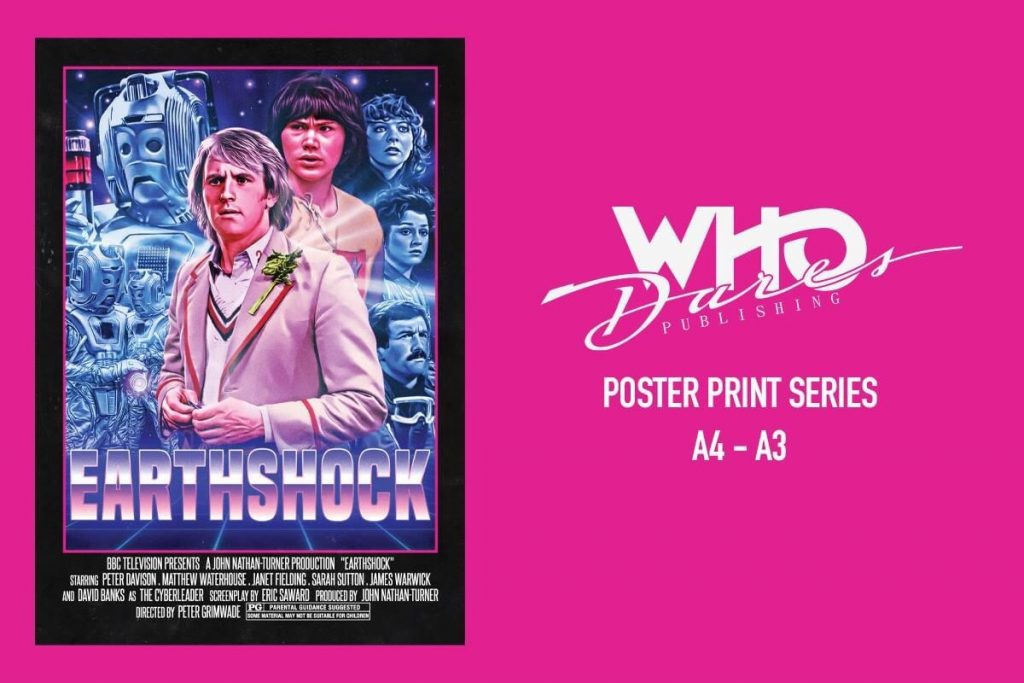
Not content with releasing some terrific Doctor Who-related projects recently through Who Dares Publishing, artist Andrew Skilleter is spoiling Dan Dare fans, too.

Available now as a new A3 giclee print is his artwork dedicated to the genius of Frank Hampson (1918 – 1985), celebrating the 70th Anniversary of his creation, Dan Dare Pilot of the Future.
Produced A3 size (297 x 420 mm/11-5 x 16.5 inches), each Art Print featuring art first released back in 2005, is produced to order, capturing the quality of the original painting and are approved and signed by Andrew Skilleter.
Suitable for framing, each is a collector’s item and available to order here on the Who Dares site.

There, you can also find Andrew’s latest work, and a new Doctor Who poster series by Oliver Arkinstall-Jones, an up and coming new digital artist the company are working closely with to bring some amazing alternative Doctor Who B style movie posters.
• Check out the full Who Dares at who-dares.co.uk/shop
The founder of downthetubes, which he established in 1998. John works as a comics and magazine editor, writer, and on promotional work for the Lakes International Comic Art Festival. He is currently editor of Star Trek Explorer, published by Titan – his third tour of duty on the title originally titled Star Trek Magazine.
Working in British comics publishing since the 1980s, his credits include editor of titles such as Doctor Who Magazine, Babylon 5 Magazine, and more. He also edited the comics anthology STRIP Magazine and edited several audio comics for ROK Comics. He has also edited several comic collections, including volumes of “Charley’s War” and “Dan Dare”.
He’s the writer of “Pilgrim: Secrets and Lies” for B7 Comics; “Crucible”, a creator-owned project with 2000AD artist Smuzz; and “Death Duty” and “Skow Dogs” with Dave Hailwood.
Categories: Art and Illustration, Doctor Who, downthetubes News, Other Worlds
 Andrew Skilleter’s new art book, Illuminart 3, spotlights more of his Doctor Who art
Andrew Skilleter’s new art book, Illuminart 3, spotlights more of his Doctor Who art  Excalibur Auctions latest “Collectors’ Cavern Auction” includes UFO film script, Gerry Anderson and Doctor Who comic art
Excalibur Auctions latest “Collectors’ Cavern Auction” includes UFO film script, Gerry Anderson and Doctor Who comic art  “Adventures in Time and Space – 60 Years of Doctor Who Art” heads to Somerset
“Adventures in Time and Space – 60 Years of Doctor Who Art” heads to Somerset  Lakes International Comic Art Festival, Doctor Who Magazine, launches children’s Doctor Who Monster Competition
Lakes International Comic Art Festival, Doctor Who Magazine, launches children’s Doctor Who Monster Competition
Frank Hampson was a genius who never understood his own strengths. Like W.E.Johns, he had a talent for producing fiction, for a mainly juvenile audience, which did not talk down and was entirely palatable to adults. After Frank left centre stage, the rot set in, with obnoxious cuddly animals, and juvenile boys for (male) readers to identify with. Before that, male readers automatically identified with Dan and his male colleagues, who were regarded as role models. The strip was pioneering in that it featured an emancipated woman among the main characters, Professor Jocelyn Peabody. Hampson also had a gift for probing the unconscious. His part of Operation Saturn in particular is full of Jungian dream images: the sinister insect shadow on the dashboard of the doomed spaceship, the literally burning eyes of the Black Cat From Saturn, the world beneath the waters of Phoebe. Editor Marcus Morris seemed to forget that he originally conceived The Eagle comic as an antidote to American horror comics, which were aimed at adults but attracted a large juvenile readership, and were regarded as a corrupting influence,